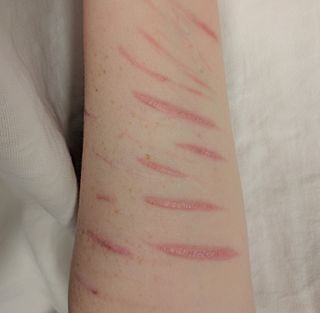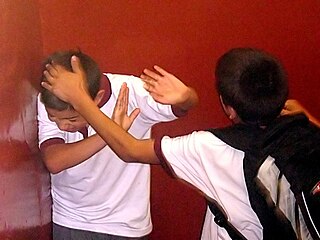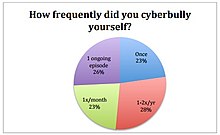
Self-harm is intentional behavior that is considered harmful to oneself. This is most commonly regarded as direct injury of one's own skin tissues usually without a suicidal intention. Other terms such as cutting, self-injury, and self-mutilation have been used for any self-harming behavior regardless of suicidal intent. Common forms of self-harm include damaging the skin with a sharp object or by scratching, hitting, or burning. The exact bounds of self-harm are imprecise, but generally exclude tissue damage that occurs as an unintended side-effect of eating disorders or substance abuse, as well as societally acceptable body modification such as tattoos and piercings.

Bullying is the use of force, coercion, hurtful teasing or threat, to abuse, aggressively dominate or intimidate. The behavior is often repeated and habitual. One essential prerequisite is the perception of an imbalance of physical or social power. This imbalance distinguishes bullying from conflict. Bullying is a subcategory of aggressive behavior characterized by hostile intent, imbalance of power and repetition over a period of time.
Suicide is the second leading cause of death for people in the United States from the ages of 9 to 56.

Self-destructive behavior is any behavior that is harmful or potentially harmful towards the person who engages in the behavior.

School bullying, like bullying outside the school context, refers to one or more perpetrators who have greater physical strength or more social power than their victim and who repeatedly act aggressively toward their victim. Bullying can be verbal or physical. Bullying, with its ongoing character, is distinct from one-off types of peer conflict. Different types of school bullying include ongoing physical, emotional, and/or verbal aggression. Cyberbullying and sexual bullying are also types of bullying. Bullying even exists in higher education. There are warning signs that suggest that a child is being bullied, a child is acting as a bully, or a child has witnessed bullying at school.
Youth suicide is when a young person, generally categorized as someone below the legal age of majority, deliberately ends their own life. Rates of youth suicide and attempted youth suicide in Western societies and other countries are high. Youth suicide attempts are more common among girls, but adolescent males are the ones who usually carry out suicide. Suicide rates in youths have nearly tripled between the 1960s and 1980s. For example, in Australia suicide is second only to motor vehicle accidents as its leading cause of death for people aged 15 to 25.
Research has found that attempted suicide rates and suicidal ideation among lesbian, gay, bisexual, and transgender (LGBT) youth are significantly higher than among the general population.
Sexting is sending, receiving, or forwarding sexually explicit messages, photographs, or videos, primarily between mobile phones. It may also include the use of a computer or any digital device. The term was first popularized early in the 21st century and is a portmanteau of sex and texting, where the latter is meant in the wide sense of sending a text possibly with images. Sexting is not an isolated phenomenon but one of many different types of sexual interaction in digital contexts that is related to sexual arousal.
Researchers study Social media and suicide to find if a correlation exists between the two. Some research has shown that there may be a correlation.
Bullying and suicide are considered together when the cause of suicide is attributable to the victim having been bullied, either in person or via social media. Writers Neil Marr and Tim Field wrote about it in their 2001 book Bullycide: Death at Playtime.
Peer victimization is the experience among children of being a target of the aggressive behavior of other children, who are not siblings and not necessarily age-mates.
Cyberbullying or cyberharassment is a form of bullying or harassment using electronic means. Cyberbullying and cyberharassment are also known as online bullying. It has become increasingly common, especially among teenagers and adolescents, due to the communication technology advancements and young people's increased use of such technologies. Cyberbullying is when someone, typically a teenager, bullies or harasses others on the internet and other digital spaces, particularly on social media sites.
Social media began in the form of generalized online communities. These online communities formed on websites like Geocities.com in 1994, Theglobe.com in 1995, and Tripod.com in 1995. Many of these early communities focused on social interaction by bringing people together through the use of chat rooms. The chat rooms encouraged users to share personal information, ideas, or even personal web pages. Later the social networking community Classmates took a different approach by simply having people link to each other by using their personal email addresses. By the late 1990s, social networking websites began to develop more advanced features to help users find and manage friends. These newer generation of social networking websites began to flourish with the emergence of SixDegrees.com in 1997, Makeoutclub in 2000, Hub Culture in 2002, and Friendster in 2002. However, the first profitable mass social networking website was the South Korean service, Cyworld. Cyworld initially launched as a blog-based website in 1999 and social networking features were added to the website in 2001. Other social networking websites emerged like Myspace in 2002, LinkedIn in 2003, and Bebo in 2005. In 2009, the social networking website Facebook became the largest social networking website in the world. Active users of Facebook increased from just a million in 2004 to over 750 million by the year 2011. Making internet-based social networking both a cultural and financial phenomenon.

Empathy has been studied in the context of online communities as it pertains to enablers of interpersonal communication, anonymity, as well as barriers to online relationships, such as ambiguity, cyberbullying and internet trolling. The importance of this topic can not be underestimated as the landscape of online use drastically changed or evolved following the Covid-19 Pandemic of 2020 which forced many in the workplace, schools and even novice tech users into new and uncomfortable situations. This forced much more time spent and reliance on the virtual world, through our computers, phones, and tablets. Schools and workplaces moved online consumers also moved online for basic needs like grocery shopping, medical appointments and a host of new virtual services that impacted all generations.
This article explains the positive and negative impacts to adolescents’ exposure to social media.
Online child abuse is a unique form of child abuse also known as “Cyber Molestation” due to its virtual, distanced, and anonymous nature. Such abuse may not happen face-to-face, nor does it necessarily require physical contact. However, online abuse can result in negative face-to-face consequences in the form of statutory rape, forcible sexual assault, harassment, etc. In the United States, online child abuse is recognized as a form of child abuse by the National Society for the Prevention of Cruelty to Children.
The relationships between digital media use and mental health have been investigated by various researchers—predominantly psychologists, sociologists, anthropologists, and medical experts—especially since the mid-1990s, after the growth of the World Wide Web. A significant body of research has explored "overuse" phenomena, commonly known as "digital addictions", or "digital dependencies." These phenomena manifest differently in many societies and cultures. Some experts have investigated the benefits of moderate digital media use in various domains, including in mental health, and the treatment of mental health problems with novel technological solutions.
Anat Brunstein-Klomek is an Israeli psychologist who is an associate professor at the Interdisciplinary Center Herzliya. She holds an adjunct position at the New York State Psychiatric Institute. Her research considers depression, suicide and bullying.
Suicide and trauma is the increased risk of suicide that is caused by psychological trauma.
Sameer Hinduja is an American social scientist. He serves as Professor of Criminology at Florida Atlantic University and co-director of the Cyberbullying Research Center. He has served as a Fulbright Specialist Scholar at Dublin City University and currently serves as Faculty Associate at the Berkman Klein Center at Harvard University. Hinduja is also the co-founder and Co-Editor-in-Chief of the International Journal of Bullying Prevention. He is an international expert in cyberbullying, sexting, sextortion, online and offline dating violence, digital self-harm, and related forms of online harm among youth. He has written seven books, including Bullying Today: Bullet Points and Best Practices, Bullying Beyond the Schoolyard: Preventing and Responding to Cyberbullying, and School Climate 2.0. His research publications have been cited approximately 20,000 times, and have appeared in such outlets as Journal of Adolescent Health, Journal of Youth and Adolescence, Journal of Interpersonal Violence, Computers in Human Behavior, and New Media and Society. Topics studied include empathy, psychological resilience, parenting, social and emotional learning, school climate, and well-being.





